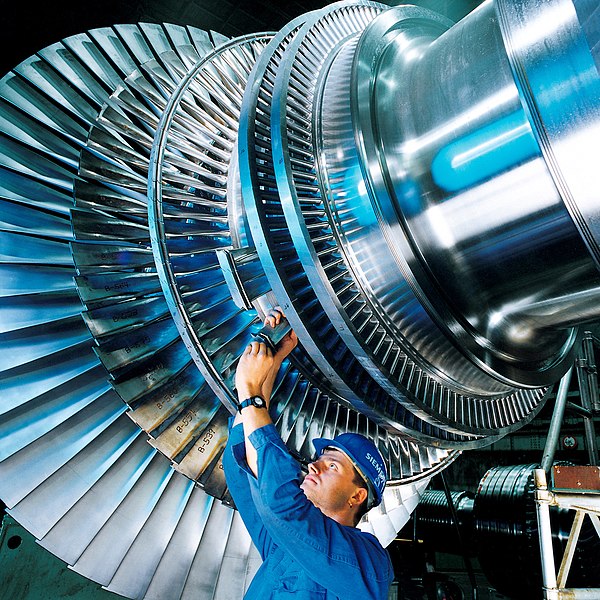A rotor of a modern steam turbine, used in a power plant.
A steam turbine consists of an alternating series of one or more rotating discs mounted on a drive shaft, rotors, and static discs fixed to the turbine casing, stators. The rotors have a propeller-like arrangement of blades at the outer edge. Steam acts upon these blades, producing rotary motion. The stator consists of a similar, but fixed, series of blades that serve to redirect the steam flow onto the next rotor stage. A steam turbine often exhausts into a surface condenser that provides a vacuum. The stages of a steam turbine are typically arranged to extract the maximum potential work from a specific velocity and pressure of steam, giving rise to a series of variably sized high and low pressure stages. Turbines are only effective if they rotate at very high speed, therefore they are usually connected to reduction gearing to drive another mechanism, such as a ship's propeller, at a lower speed. This gearbox can be mechanical but today it is more common to use an alternator/generator set to produce electricity that later is used to drive an electric motor. A turbine rotor is also only capable of providing power when rotating in one direction. Therefore a reversing stage or gearbox is usually required where power is required in the opposite direction.
Steam turbines provide direct rotational force and therefore do not require a linkage mechanism to convert reciprocating to rotary motion. Thus, they produce smoother rotational forces on the output shaft. This contributes to a lower maintenance requirement and less wear on the machinery they power than a comparable reciprocating engine.
The Turbinia - the first steam turbine-powered ship.
The main use for steam turbines is in electricity generation (about 80% of the world's electric production is by use of steam turbines)[citation needed] and to a lesser extent as marine prime movers. In the former, the high speed of rotation is an advantage, and in both cases the relative bulk is not a disadvantage; in the latter (pioneered on the Turbinia), the light weight, high efficiency and high power are highly desirable.
Virtually all nuclear power plants generate electricity by heating water to provide steam that drives a turbine connected to an electrical generator. Nuclear-powered ships and submarines either use a steam turbine directly for main propulsion, with generators providing auxiliary power, or else employ turbo-electric propulsion, where the steam drives a turbine-generator set with propulsion provided by electric motors. A limited number of steam turbine railroad locomotives were manufactured. Some non-condensing direct-drive locomotives did meet with some success for long haul freight operations in Sweden and for express passenger work in Britain, but were not repeated. Elsewhere, notably in the U.S.A., more advanced designs with electric transmission were built experimentally, but not reproduced. It was found that steam turbines were not ideally suited to the railroad environment and these locomotives failed to oust the classic reciprocating steam unit in the way that modern diesel and electric traction has done.
Source: Wikipedia.


Nice stuff dear. I like it load bank hire & generator maintenance
ReplyDelete